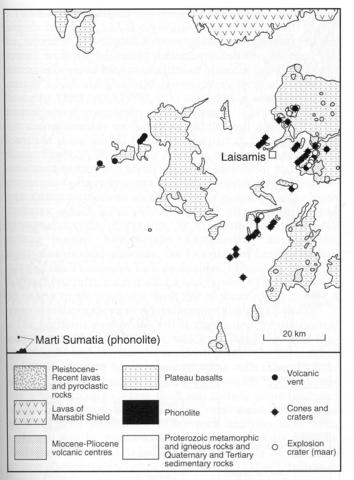stripes
Lavas of olivine basalt form plateaux in the northeast (southwest margin of the Marsabit centre; No. 085-00-09), east, a large area in the centre and a smaller area in the northwest of the Laisamis degree sheet (Charsley, 1987b). Some of the basalts contain analcime. Over 45 volcanic centres, including ash and scoria cones and craters, explosion craters (maars) and lava accumulations, up to 100 m high, have been identified on the plateaux. The rocks of these centres are generally more alkaline than the plateau basalts and include olivine melanephelinite, basanite and hawaiite (Charsley, 1987b). Basanites described by Rix (1973) from the southeast of the area comprise Ti-augite and olivine phenocrysts in a groundmass of labradorite, pyroxene, magnetite and nepheline. The nephelinites, and some basanite, form an aligned series of well preserved cones and associated flows that ran along valleys near Merille (Rix, 1973). The nephelinite generally consists of olivine phenocrysts in a matrix of augite, magnetite and nepheline, but melanite has also been identified. Nephelinite and basanite can apparently co-exist in a single flow. Chromian spinel-bearing harzburgite-lherzolite nodules from the olivine melanephelinite scoria cone of Ndonyuo Olnchorohave have been described by Suwa et al. (1975) and Aoki and Suwa (1977). A small area of phonolite lavas 15-20 m thick outcrops on the Marti Sumatia plateau in the extreme southwest of the area, being the most northerly part of a long flow, the ‘Barsalinga tongue’, lying in the map sheet to the south (Isiola area: Kenya No. 085-00-036). The phonolite contains nepheline and/or sanidine phenocrysts in a groundmass of the same minerals, aegirine-augite, probable aenigmatite, glass and minor analcime.
AOKI, K. and SUWA, K. 1977. Major element geochemistry of peridotite nodules from Samburu District. Second Preliminary Report of African Studies (Earth Sciences 2), Nagoya University, 2:161-4.BROTZU, P., MORBIDELLI, L., NICOLETTI, M., PICCIRILLO, E.M. and TRAVERSA, G. 1984. Miocene to Quaternary volcanism in eastern Kenya: sequence and geochronology. Tectonophysics, 101: 75-86.CHARSLEY. T.J. 1987b. Geology of the Laisamis area. Report, Geological Survey of Kenya, 106: 1-70.RIX, P. 1973. Geology of the Kauro-Merille area. Report, Geological Survey of Kenya, 92: 1-29.SUWA, K., YUSA, Y and KISHIDA, N. 1975. Petrology of peridotite nodules from Ndonyuo Olnchoro, Samburu District, central Kenya. In L.H. Ahrens, J.B. Dawson, A.R. Duncan and A.J. Erlank (eds) Physics and Chemistry of the Earth, 9: 273-86.

